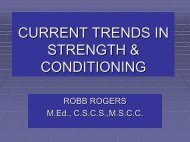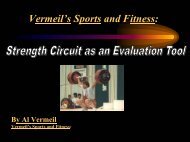The Westside System of Powerlifting: Applications for Athletes - sbc
The Westside System of Powerlifting: Applications for Athletes - sbc
The Westside System of Powerlifting: Applications for Athletes - sbc
Create successful ePaper yourself
Turn your PDF publications into a flip-book with our unique Google optimized e-Paper software.
<strong>The</strong> <strong>Westside</strong> <strong>System</strong> <strong>of</strong><br />
<strong>Powerlifting</strong>: <strong>Applications</strong> <strong>for</strong><br />
<strong>Athletes</strong><br />
Eric Cressey, MA Candidate, CSCS<br />
Assistant Editor, Rugged Magazine
<strong>The</strong> <strong>Westside</strong> <strong>System</strong> <strong>of</strong><br />
<strong>Powerlifting</strong><br />
• Created by Louie<br />
Simmons<br />
• Constantly being refined<br />
– Updated by Simmons and<br />
his disciples<br />
– Adapted by strength<br />
coaches<br />
• Conjugated Periodization -<br />
avoids some flaws <strong>of</strong><br />
traditional periodization<br />
schemes<br />
• Train it all together!<br />
Source: www.t-mag.com
<strong>Westside</strong> Principles<br />
<strong>Westside</strong> Principles<br />
• <strong>The</strong> Maximal Ef<strong>for</strong>t Method<br />
– Builds strength speed and absolute strength<br />
– Improves neuromuscular coordination by increasing motor<br />
unit recruitment, rate coding, and motor unit synchronization<br />
• <strong>The</strong> Dynamic Ef<strong>for</strong>t Method<br />
– Builds explosiveness (ability to achieve maximum <strong>for</strong>ce<br />
ASAP after a muscular stretch), rate <strong>of</strong> <strong>for</strong>ce development,<br />
and speed strength (50-60% 1RM)<br />
– Lifting submaximal weights at highest possible speed<br />
• <strong>The</strong> Repetition Method<br />
– Promotes strength endurance and hypertrophy, strengthens<br />
neural/muscular deficiencies, and increases work capacity<br />
– Lifting a non-maximal load to failure or near-failure
<strong>Westside</strong> Principles: Sample Split<br />
•Monday: Max Ef<strong>for</strong>t Squat/Deadlift Day<br />
•Wednesday: Max Ef<strong>for</strong>t Bench Day<br />
•Friday: Dynamic Ef<strong>for</strong>t Squat/Deadlift Day<br />
•Saturday: Dynamic Ef<strong>for</strong>t Bench Day<br />
*Other variations (e.g. MWF) have also been<br />
implemented successfully. <strong>The</strong> split is also<br />
influenced by prioritization <strong>of</strong> weaknesses.
A Typical Max Ef<strong>for</strong>t<br />
Squat/Deadlift Day<br />
1) One Max Ef<strong>for</strong>t Exercise: Good Mornings (~70%),<br />
Low Box squat (~20%), Deadlift (~10%). Work up to<br />
3RM, and then a 1RM. Exercise choice is governed<br />
by lifter’s weakness.<br />
2) Supplemental Exercise <strong>for</strong> the Posterior Chain: GHRs,<br />
SLDLs, RDLs, Pull-throughs (6-20 reps)<br />
3) Accessory #1 - Posterior Chain: Reverse Hypers,<br />
Hyperextensions (6-20 reps)<br />
4) Accessory #2 – Core: Pulldown Abs, Straight Leg<br />
Raises, Weighted Side Bends, Weighted Decline Situps<br />
(6-20 reps)
Max Ef<strong>for</strong>t Squat/Deadlift<br />
Exercises<br />
Source: www.bsu.edu/webapps/strengthlab/Home.htm
A Typical Max Ef<strong>for</strong>t Bench Day<br />
1) One Max Ef<strong>for</strong>t Exercise: Bench Press, Board (1-5)<br />
Press, Floor Press, Close Grip Bench Press, Incline<br />
Press, High Rep Stability Ball DB Presses (every 10<br />
weeks). Work up to 3RM, and then a 1RM.<br />
2) Supplemental Triceps Exercise: Lying Extension and<br />
Press variations (6-20 reps)<br />
3) Accessory #1 – Back: Rows emphasized, although<br />
vertical pulling is utilized occasionally (6-20 reps)<br />
4) Accessory #2 – Shoulders or Extra Triceps: Presses<br />
and raises, extensions and presses, respectively (6-20<br />
reps)
A Typical Dynamic Ef<strong>for</strong>t<br />
Squat/Deadlift Day<br />
1) Box Squats: 8-12 sets x 2 reps at 50-60% 1RM as fast<br />
as possible, 45-60 seconds between sets<br />
2) Supplemental Exercise <strong>for</strong> the Posterior Chain: GHRs,<br />
SLDLs, RDLs, Pull-throughs (3-20 reps)<br />
3) Accessory #1 - Posterior Chain: Reverse Hypers,<br />
Hyperextensions (6-20 reps)<br />
4) Accessory #2 – Core: Pulldown Abs, Straight Leg<br />
Raises, Weighted Side Bends, Weighted Decline Situps<br />
(6-20 reps)
Max Ef<strong>for</strong>t Bench Exercises<br />
Source: www.bsu.edu/webapps/strengthlab/Home.htm
A Typical Dynamic Ef<strong>for</strong>t Bench<br />
Day<br />
1) Speed Bench, three separate grips: 8-10 sets x 3 reps<br />
at 50-60% 1RM as fast as possible, 45-60 seconds<br />
between sets<br />
2) Supplemental Triceps Exercise: Lying Extension and<br />
Press variations (3-20 reps)<br />
3) Accessory #1 – Back: Rows emphasized, although<br />
vertical pulling is utilized occasionally (6-20 reps)<br />
4) Accessory #2 – Shoulders or Extra Triceps: Presses<br />
and raises, extensions and presses, respectively (6-20<br />
reps)
Important Notes<br />
• <strong>The</strong> max ef<strong>for</strong>t exercises should be changed every 1-3<br />
weeks (more <strong>of</strong>ten <strong>for</strong> experienced lifters). Training<br />
at 90% 1RM or more <strong>for</strong> 3+ weeks with the same<br />
exercise is associated with stagnation; switching<br />
exercises enables one to continue training at 100% and<br />
above 1RM without burnout.<br />
• Accessory exercises are changed every 2-3 weeks.<br />
• Some individuals per<strong>for</strong>m more exercises with fewer<br />
sets <strong>of</strong> each on assistance exercises.<br />
• Some individuals train back with lower body sessions,<br />
and some split back training into horizontal and<br />
vertical pushing and pulling (train back 4x/week).
Extra Workouts<br />
• May be actual training sessions aimed at bringing<br />
up weaknesses (not full sessions) per<strong>for</strong>med on<br />
<strong>of</strong>f-days or several hours after a ME or DE<br />
session.<br />
• May be General Physical Preparedness (GPP):<br />
sled dragging, strongman implements, tubing/light<br />
weight exercises specific to lifts and involved<br />
joints, Javorek complexes, body weight circuits <strong>of</strong><br />
short duration
<strong>Westside</strong> GPP<br />
GPP training has many functions:<br />
1) fostering, strengthening or restoring habits (skills) that play a<br />
role in sports per<strong>for</strong>mance<br />
2) Increasing or preserving the general work capacity or preserving<br />
it<br />
3) Assisting the restoration process (active rest)<br />
4) Reducing the likelihood <strong>of</strong> injury<br />
5) Preventing the onset <strong>of</strong> monotony in training<br />
As an athlete’s GPP improves, so too does his/her ability to adapt<br />
to new training stimuli and sport demands. From a powerlifting<br />
standpoint, GPP is important because one must be conditioned<br />
physically and mentally to per<strong>for</strong>m nine maximal lifts in a<br />
period <strong>of</strong> 6-9 hours.
Important Notes<br />
• <strong>The</strong> beauty <strong>of</strong> <strong>Westside</strong> is its versatility as a<br />
template; exercise selection and loading<br />
parameters on supplemental and accessory<br />
exercises are dictated by the individual’s<br />
weaknesses and access to equipment.<br />
• May include lunges, cleans, pullups/pulldowns,<br />
single-leg squats, etc.<br />
• Scapular Stability/Rotator Cuff work can be<br />
incorporated at the end <strong>of</strong> both benching sessions.<br />
Some individuals per<strong>for</strong>m specific grip and neck<br />
training as well.
Important Notes<br />
• Volume Manipulation is not as black and white as<br />
in traditional periodization schemes.<br />
• A lifter’s attention to recovery, GPP, and overall<br />
work capacity dictates frequency <strong>of</strong> down weeks.<br />
• Typical beginner programs have been designed in<br />
9-week mesocycles consisting <strong>of</strong> 3-week<br />
microcycles. Week 9 serves as testing only (or<br />
competition). <strong>The</strong>se results are used as the basis<br />
<strong>for</strong> the next mesocycle.
Accommodating Resistances<br />
• Bands and Chains<br />
• Can be used on both max and dynamic ef<strong>for</strong>t exercises<br />
• Useful <strong>for</strong> a variety <strong>of</strong> assistance exercises, too<br />
• Goals<br />
– On dynamic ef<strong>for</strong>t days, maintain original weight (50-60% 1RM),<br />
which is required to yield explosive training benefits<br />
– Overload the top portion <strong>of</strong> the lift (undertrained due to increased<br />
body leverage at this position)<br />
– Foster a neurological explosive strength pattern that doesn’t allow<br />
one to “get lazy” at the top.<br />
– Learning to “outrun the bands” teaches you to develop the fast start<br />
needed to lock out a heavier weight.<br />
– Effectively train the start and lockout simultaneously
Can <strong>Westside</strong> be used with<br />
athletes?<br />
“<strong>The</strong> other day I got <strong>of</strong>f the phone with a friend <strong>of</strong> mine who<br />
coaches college football. I told him that I had recently<br />
consulted with Dave Tate about applying the <strong>Westside</strong><br />
principles <strong>for</strong> a college football player. He asked if these<br />
ideas were applicable <strong>for</strong> athletes, since <strong>Westside</strong> is a<br />
powerlifting gym. I responded by asking him what was<br />
wrong with having explosive athletes with a strong<br />
posterior chain, setting and breaking records every week,<br />
keeping a high intensity level in the gym and competition<br />
amongst players.”<br />
-Jim Wendler<br />
www.elitefts.com
Benefits <strong>for</strong> <strong>Athletes</strong><br />
•Overwhelming emphasis on posterior chain<br />
Source: www.bsu.edu/webapps/strengthlab/Home.htm
Benefits <strong>for</strong> <strong>Athletes</strong><br />
• A 1-3 RM is attempted nearly every week <strong>for</strong> both<br />
the upper and lower body<br />
– Provides strength coach with constant feedback on<br />
athletes’ progress<br />
– Provides athletes with pro<strong>of</strong> that hard work is paying<br />
<strong>of</strong>f<br />
– Appropriate cycling <strong>of</strong> max ef<strong>for</strong>t exercises decreases<br />
likelihood <strong>of</strong> failure<br />
– Serves as a means <strong>of</strong> testing within each week<br />
– Avoids having to always put limit strength behind<br />
power – establishes static-spring pr<strong>of</strong>iciency
Benefits <strong>for</strong> <strong>Athletes</strong><br />
• Utilization <strong>of</strong> accomodating resistances teaches<br />
athletes to not get lazy in easiest portions <strong>of</strong> ROM<br />
• Pays specific attention to commonly neglected<br />
muscle groups<br />
– Importance <strong>of</strong> back in bench press<br />
– Grip work (direct and indirect)<br />
– Major emphasis on core, triceps, hamstrings,<br />
scapular stabilizers
Benefits <strong>for</strong> <strong>Athletes</strong><br />
•Avoids traditional pitfalls <strong>of</strong> linear<br />
periodization by addressing all types <strong>of</strong><br />
strength in the same training period<br />
– Absolute Strength<br />
– Strength Endurance<br />
– Speed-Strength<br />
– Explosive Strength<br />
– Accelerating Strength
<strong>The</strong> Types <strong>of</strong> Strength<br />
Explosive Strength: ability to achieve maximal <strong>for</strong>ce<br />
as quickly as possible, usually after a pre-stretch<br />
Speed-strength: ability to execute a movement<br />
quickly against little or no external resistance -<br />
most important with lighter loads<br />
Starting-strength: ability to develop <strong>for</strong>ce at<br />
beginning <strong>of</strong> contraction be<strong>for</strong>e external<br />
movement occurs<br />
Accelerating Strength: ability to accumulate working<br />
<strong>for</strong>ce once contraction has begun
<strong>The</strong> Types <strong>of</strong> Strength<br />
Four components <strong>of</strong> explosive strength:<br />
– Absolute strength<br />
– Acceleration-strength<br />
– Starting-strength<br />
– Absolute speed<br />
• Former two contribute most with larger external<br />
resistances; the latter two contribute more with<br />
smaller external resistances.<br />
• <strong>The</strong>se components do NOT work independently <strong>of</strong><br />
one another; starting-strength is a crucial<br />
<strong>for</strong>erunner to acceleration strength.
Important Modifications <strong>for</strong><br />
• Integrate O-lifts with box<br />
squats and speed pulls as<br />
dynamic ef<strong>for</strong>t exercises<br />
<strong>for</strong> lower body<br />
• Integrate Push Jerks, Push<br />
Presses, Hang Snatches,<br />
Overspeed Chins, and<br />
Medicine Ball throws with<br />
dynamic ef<strong>for</strong>t bench<br />
pressing<br />
<strong>Athletes</strong><br />
Source: www.bsu.edu/webapps/strengthlab/Home.htm
Important Modifications <strong>for</strong><br />
<strong>Athletes</strong><br />
• Substitute max ef<strong>for</strong>t<br />
exercises that are specific<br />
to the sport (e.g. weighted<br />
chins <strong>for</strong> tennis, baseball,<br />
volleyball)<br />
• Include traditional “quadsquatting”<br />
to ensure<br />
optimal knee extensor<br />
contributions<br />
• Incorporate deepersquats/lunges<br />
to work<br />
<strong>of</strong>ten-neglected VMO<br />
Source: www.bsu.edu/webapps/strengthlab/Home.htm
Important Modifications <strong>for</strong><br />
<strong>Athletes</strong><br />
•Traditional <strong>Westside</strong> GPP and extra<br />
workouts are replaced by:<br />
– Sport-specific practices<br />
– Agility work<br />
– Conditioning<br />
– Subsystems (may also be included in GPP-like<br />
warm-ups)
Important Modifications <strong>for</strong><br />
<strong>Athletes</strong><br />
• Include single leg/split<br />
stance exercise in each<br />
lower body session<br />
– May be per<strong>for</strong>med as an O-<br />
lift variation or assistance<br />
exercise, but MUST ensure<br />
significant loading (e.g.<br />
lateral movements that<br />
compromise weight are<br />
better placed in GPP<br />
sessions)<br />
• Ensure appropriate<br />
balance <strong>of</strong> horizontal and<br />
vertical pushing and<br />
pulling exercises<br />
Source: www.bsu.edu/webapps/strengthlab/Home.htm
Important Modification <strong>for</strong><br />
<strong>Athletes</strong><br />
• Some younger athletes – especially those <strong>for</strong> whom<br />
hypertrophy is a <strong>for</strong>emost goal – may be better <strong>of</strong>f with a<br />
repetition day instead <strong>of</strong> a dynamic ef<strong>for</strong>t day. This is<br />
especially important if they are not strong enough to train<br />
with considerable resistance on their dynamic ef<strong>for</strong>t days.<br />
• During the competitive season or periods when outside<br />
conditioning (e.g. sprinting) volume is quite high, it may<br />
be appropriate to eliminate the dynamic ef<strong>for</strong>t lower body<br />
session altogether.<br />
• In essence, the speed demands <strong>of</strong> participation in the sport<br />
are allowed to take care <strong>of</strong> themselves in these situations.
Potential Problems<br />
• Inattentiveness <strong>of</strong> strength coach in manipulating<br />
volume and monitoring progress (coach must<br />
recognize when sessions should be missed or<br />
volume/intensity should remain unchanged)<br />
• Lack <strong>of</strong> athlete motivation<br />
• Poor exercise economy<br />
• Missed Training Sessions<br />
• Too much, too soon (a base level <strong>of</strong> fitness –<br />
especially core stability – must precede a<br />
<strong>Westside</strong>-influenced program)
References & Further Reading<br />
• www.elitefts.com<br />
• www.deepsquatter.com<br />
• www.defrancostraining.com<br />
• www.t-mag.com<br />
• <strong>The</strong> Coach’s Strength Training Playbook, by Joe<br />
Kenn<br />
• Supertraining, by Mel Siff and Yuri Verkoshansky<br />
• <strong>The</strong> Science and Practice <strong>of</strong> Strength Training, by<br />
Vladimir Zatsiorsky
A Final Note<br />
A special thanks goes out to the Mike<br />
Robertson, Dr. Robert Newton, and the rest<br />
<strong>of</strong> the members <strong>of</strong> the Ball State University<br />
Human Per<strong>for</strong>mance Laboratory <strong>for</strong><br />
providing all the photos <strong>for</strong> this<br />
presentation.<br />
www.bsu.edu/webapps/strengthlab/Home.htm
About the Presenter<br />
Eric Cressey, CSCS, assistant editor <strong>of</strong> Rugged Magazine<br />
(www.ruggedmag.com), is currently pursuing a Master's Degree in<br />
Kinesiology with a concentration in Exercise Science at the University<br />
<strong>of</strong> Connecticut. He graduated from the University <strong>of</strong> New England<br />
with a double major in Exercise Science and Sports and Fitness<br />
Management. Although prepared in a variety <strong>of</strong> bodies <strong>of</strong> knowledge,<br />
Eric specializes in applied kinesiology and biomechanics as they relate<br />
to program design and injury rehabilitation. As a freelance writer, Eric<br />
has had over two dozen publications among Rugged Magazine,<br />
Testosterone Magazine, johnberardi.com. A competitive powerlifter,<br />
Eric has experience in athletic per<strong>for</strong>mance, rehabilitation, and general<br />
conditioning settings with a variety <strong>of</strong> populations. He’s also one hell<br />
<strong>of</strong> a nice guy, so feel free to contact him at<br />
eric_cressey@ruggedmag.com!










